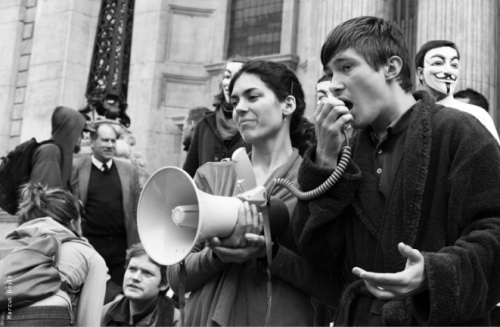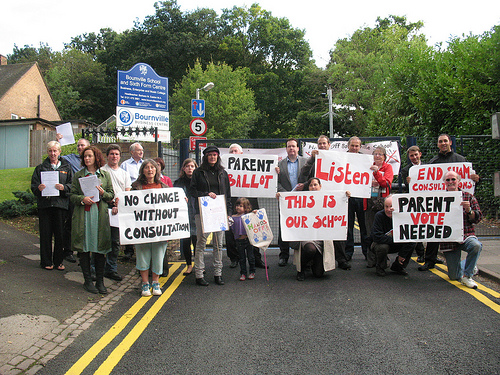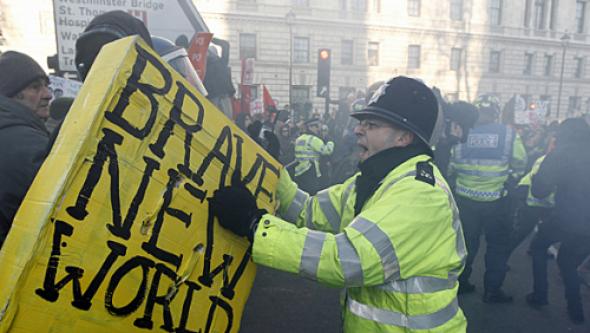What Next For Education Struggles
After last August’s riots Sarah Taylor asks, will the contradictions of last year’s student movement resolve or simply extend themselves?
Last year was so simple. The government wanted to triple fees and there was a vote coming up. Smashing Millbank made everything seem possible. Demonstrations stopped going where they were told, school students played truant to run riot in Oxford Street, occupations at universities became the norm. But the vote was lost. Tired and cold, we went home and didn’t come back.
A year later, the lectures and lessons have restarted and the student demonstrations are planned again. The first is on 9 November* – a year since the occupation of Millbank. But what do we do on this anniversary? If it was all about the vote on tuition fees and keeping Educational Maintenance Allowance, then perhaps we should lay a wreath for the lost fight – for the university students filming themselves Twittering in occupations, and for the school students smashing up shops, for dance-offs in libraries and grime in kettles.1 But if it was about something more, and if all these people are still angry, what happens next?
National Campaign Against Fees and Cuts (NCAFC) and the Education Activist Network (EAN) called the 9 November protest. The National Union of Students (NUS), now apparently resigned to its insignificance, officially supports the demonstration, and has agreed to provide some resources to help publicise it, although this doesn’t seem to stretch to the use of its website, which currently headlines ‘Freshers’ advice from the cast of Hollyoaks.’2 Filling the hole left by the NUS, the new student organisations are looking a lot like the old left. EAN was never shy of being the offspring of the ageing Socialist Workers Party, and although NCAFC was originally a loose network of students, over the summer it elected itself a National Committee with 14 permanent members and now describes itself as one of the organisations that ‘led’ the student protests.3
It works both ways – the old left also wants to emulate the students. Last year, Unite’s Len McCluskey wrote in The Guardian,
Britain’s students have certainly put the trade union movement on the spot. Their mass protests against the tuition fees increase have refreshed the political parts a hundred debates, conferences and resolutions could not reach […] The magnificent students’ movement urgently needs to find a wider echo if the government is to be stopped.
But he also thinks that any ‘wider echo’ will need trade unions to give ‘guidance’ to people’s anger, to ‘put it in a manner that will hopefully make the government take a step back.’
On 30 November, public sector workers will walk out over pensions, in what is set to be the biggest strike since the 1926 general strike. Education workers are the most obvious point of contact between the strikers and the students. Most teaching unions, ranging from the large and relatively militant National Union of Teachers to the small and conservative Association of Teachers and Lecturers, will be walking out. The higher and further education union, the University and College Union, will also be on strike. In a show of solidarity, the NUS leader warns, ‘Any action that threatens students’ ability to progress from year to year, or graduate at all, will immediately lose student support.’4 Leaving the NUS to the cast of Hollyoaks, NCAFC and EAN have called for student walkouts and direct action on the day of the strike. A similar call-out for the smaller 30 June public sector strike met with little response, but away from end of term lethargy, and with more workers on strike, young people might be tempted onto the streets.

Image: Occupy LSX, London, 2011
Yet, as the last strike indicated, the government is not really fazed by one-day strikes – far from stepping back, it steps over them and keeps on going. Even if students do decide to join in the struggle for pensions, the government is unlikely to feel threatened by 12 hours of adults and children fighting to retire.
But you would be hard pushed to find a subject further from the minds of young people than pensions. Even the striking teachers will tell you that it is work and not retirement that really frightens them. The schools White Paper and the higher education White Paper map out similar plans to deepen the privatisation of the education system: both drive educational institutions into the hands of corporations; both see students and parents as consumers looking for ‘choice’ or ‘value for money’; both threaten teachers’ and lecturers’ nationally agreed pay and conditions; and both create a two-tier system in which adequately funded education is reserved for the well informed and well moneyed.
The government has engineered the cap on university places in such a way that the Russell Group universities are allowed to siphon off more students with grades AAB and above, and other universities, having lost these students, are encouraged to drop fees below £7,500 to compete with private providers for a pool of 20,000 extra places. Meanwhile, the government’s ‘free schools’ allow groups of middle class parents to open schools, with education corporations taking over when they find they have bitten off more than they can chew. If that wasn’t enough, Labour’s Academies, increasingly part of corporation or church-run chains, have been extended to include primary schools. Senior civil servants (who, incidentally, and confusingly, might also join the strike on 30 November) showed their sense of humour by naming the schools White Paper, ‘The Importance of Teaching’ and the higher education White Paper, ‘Students at the Heart of the System’.
But schools are not only subject to direct attacks – they also suffer from the removal of benefits, wages, houses and every other meagre compensation that was previously offered to children and their families. I will take a primary school and secondary school I know as examples of this, but these are by no means isolated cases – the same stories can be heard in schools across the country.

Image: Anti-Academies Alliance Bournville
The primary school, where 48 percent of the children are on free school meals, but which is located in a rich London borough, expects to lose half of its pupils once the national housing benefit cap comes into effect – no longer able to afford to rent their own homes, their families will be forced to move from the borough or face eviction. To make things worse, because only three percent of primary schools have taken up Education Minister Michael Gove’s generous offer for them to voluntarily become Academies, schools like this one are going to be forced to become Academies next year if they don’t fulfil certain, impossible to fulfil, criteria.
The secondary school, based in rural Wales, is facing falling student enrolment as factory after factory in the area is closed and, with dwindling funds from low intake, middle class parents exercising their ‘parental choice’ decide to send their children elsewhere. This school is likely to be one of half the schools shut down in the county under a PricewaterhouseCoopers’ consulted ‘modernisation’ programme, which will see the end of schools that have been the centre of villages and towns for generations, and will force children to travel for up to an hour on country roads before they get to their first lesson.
Once they’ve left school, more and more of these children won’t be able to afford to go to college, let alone university. Many of them won’t get jobs, won’t get benefits, won’t get houses. They can only dream of retirement. The government has something right, students are at the heart of the system, and it beats at them from all sides.
This was clearly expressed in August when, away from the constraints of term time, articulated demands, symbolic targets and organising committees, Britain’s teenagers went rioting. The same McCluskey who heaped praise upon the student riots described the August riots as ‘the exact opposite of community spirit, collectivism and what trade unionism is all about.’5 While, a year on from the student riots, many of those arrested are still awaiting trial, the August riots saw courts operating throughout the night, getting people off the streets and into prison as quickly as possible. Some of those arrested during the student protests who were unfortunate enough to be tried immediately after the summer riots, found themselves with harsher sentences than students convicted of exactly the same crimes before the riots. The August riots shook the authorities in a way that the student riots did not. Anything that happens next will have to be seen through the smoke of Tottenham, Croydon, Manchester and Birmingham.
The difference between the winter’s student riots and the summer’s standard riots is something the student leaders have been keen to reinforce. NCAFC patronise the young ‘victims’, telling them their rioting ‘will not improve the situation’, and arguing that their anger ‘needs to be channelled into tackling the real causes of injustice and inequality.’6 By which we can only assume they mean Topshop, Camilla Parker-Bowles, an office block in Millbank, the windows of the treasury, Barclays bank, parliamentary votes and the police, rather than Footlocker, the Sony warehouse, JD Sports, Carphone Warehouse, jewellery shops, furniture chains and the police. A good riot announces itself with a protest beforehand, has a symbolic target and a view of Big Ben. A bad riot is localised, unplanned, gets you free trainers, and can even happen when politicians are away on holiday. Good riots have uncontrollable fire extinguishers, bad riots have uncontrollable fires.
The attempt to divide the good and the bad ignores the fact that the summer riots are a continuation of, rather than a break with, the winter riots. The summer riots happened because the winter riots were never going to tackle ‘the real causes of justice and inequality.’ They happened because the winter riots were survived by a lot of angry people who knew that parliamentary votes had nothing to do with them. They gave up asking for £30 a week – they took what they wanted and destroyed what they hated, and they didn’t need to go to central London for that, because it was right outside their doors.
One intrepid reporter of student protest fame spent the August riots ‘huddled’ on the unconvincing front line that is her living room – ‘where I am in Holloway, the violence is coming closer.’ ‘Shell-shocked’, she advises her readers to follow the #riotcleanup hashtag on Twitter.7 The divide between the university students and the school students, even if now only faintly drawn, could be a sign of worse to come. The video shot during the student protests in which university students grab hold of a boy who’d thrown something burning, and attempt to hand him over to the police, a video which was posted online and subsequently on the Metropolitan Police Wanted list, was reminiscent of those much deeper divides in Paris between the university students and those from the suburbs during the anti-CPE protests. Although NCAFC’s statement on the August rioters is more of a patronising ticking off than condemnation, it shows that the student ‘spokespeople’ fear association with a more uncontainable – unkettlable – battle. It shows the fear, perhaps, that they might be about to lose control.
But it is precisely these more complicated, uncontrollable battles that provide the possibility for something more than a nostalgic reconstruction of the good old days of 2010. As people are evicted from their homes, lose their jobs, are beaten up by police; as their schools are privatised, universities go bankrupt and libraries are destroyed, resistance will have to happen there and then – on a thousand front lines, in street battles and marches, in ongoing strikes and occupations. We will only hear the ‘wider echo’ of the student protests when anger can no longer be muffled in days out at Westminster, articulated in simple slogans, or separated into causes – when a riot can no longer be just a student riot, and a struggle can no longer be just an education struggle.
Sarah Taylor <sarah.taylor55@yahoo.com> has just stopped being a student. She now has nothing better to do than write about student protests
* This article was written before the 9 November student demonstrate and 30 November public sector walkout.
Footnotes
1Educational Maintenance Allowance is a weekly means tested payment of up to £30 given to young people in further education. The scheme was closed to new applicants from England in January 2011.
2NCAFC website, ‘NUS officially supports November 9th national demonstration’, 22 September 2011, http://anticuts.com/2011/09/22/nus-officially-supp... and NUS website, http://www.nus.org.uk
3NCAFC website, ‘NCAFC statement on the riots’, 11 August 2011, http://anticuts.com/?s=riots
4Quoted in John Morgan, ‘Pension action plans threaten NUS-UCU alliance’, 13 October 2011, http://www.timeshighereducation.co.uk/story.aspsec...
5Quoted in Toby Helm, ‘Unite leader Len McCluskey calls for protests and strikes against cuts’, 10 September 2011, http://www.guardian.co.uk/politics/2011/sep/10/uni...
6NCAFC website, ‘NCAFC statement on the riots’, 11 August 2011, http://anticuts.com/?s=riots
7Laurie Penny, ‘Panic on the streets of London’, 9 August 2011, http://pennyred.blogspot.com/2011/08/panic-on-stre...
Mute Books Orders
For Mute Books distribution contact Anagram Books
contact@anagrambooks.com
For online purchases visit anagrambooks.com








